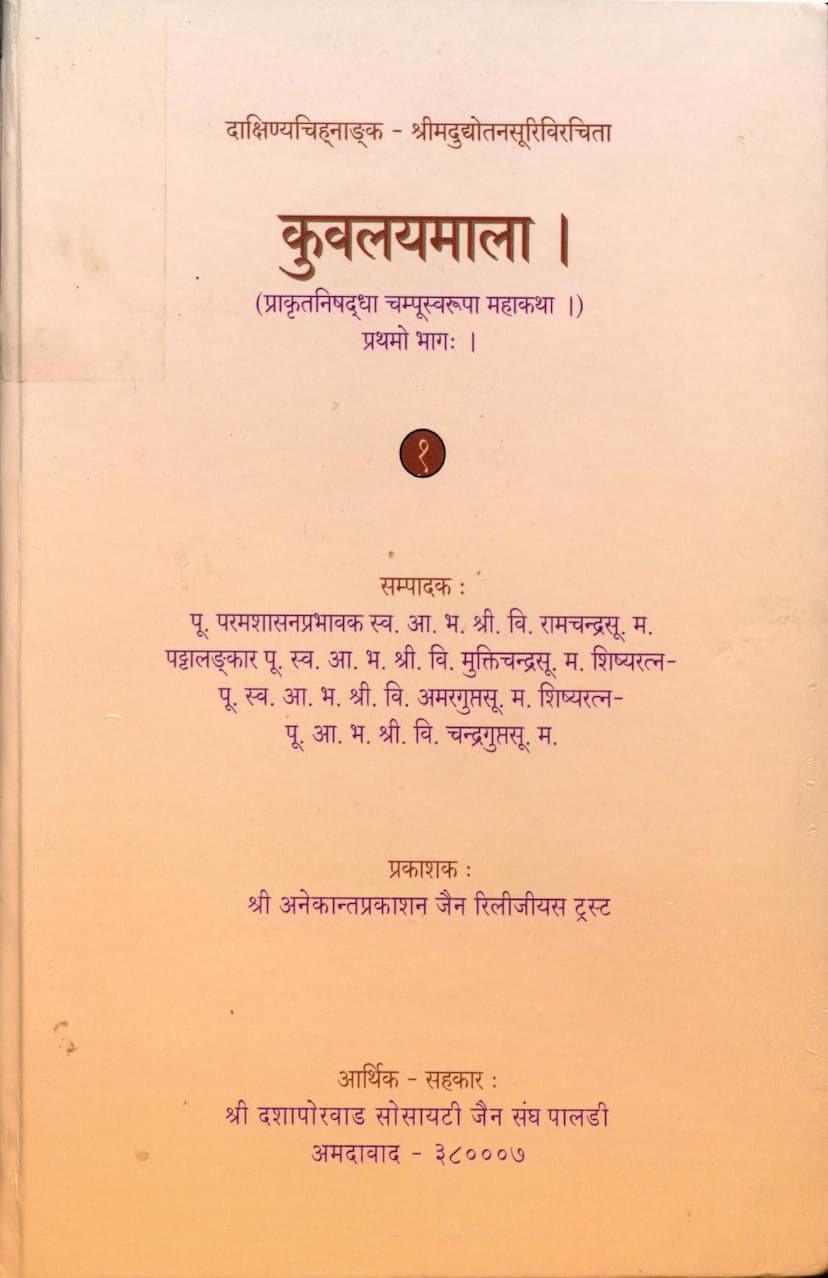Kuvalaymala Part 01
Added to library: September 2, 2025

Summary
Here's a comprehensive summary of the Jain text "Kuvalaymala Part 01" by Chandraguptasuri, based on the provided pages:
Overview:
"Kuvalaymala" is a magnum opus by Acharya Udyotan Suri, presented as a champū (a literary genre blending prose and verse) and a grand narrative (mahā kathā) in Prakrit. This summary covers the initial sections of the first volume, which lay the groundwork for the epic story. The text is notable for its detailed descriptions, philosophical insights, and complex narrative structure.
Introduction and Salutations:
The text begins with traditional Jain invocations, paying homage to the Jinas (victorious ones, often referring to the Tirthankaras). The author emphasizes the greatness of the Jinas, whose teachings, when followed, lead to the highest spiritual state, moksha.
The Value of Human Birth:
A significant portion of the early chapters is dedicated to explaining the extreme rarity and immense value of obtaining a human birth. The text vividly describes the cycle of transmigration (samsara) through various hellish realms (naraka), animal births (tiriy), and celestial abodes (deva). It illustrates how beings, trapped in suffering due to their karma, endure immense pain and hardship in these lower states. The text emphasizes that human birth is a precious opportunity, a prerequisite for acquiring true knowledge, practicing virtue, and ultimately achieving liberation.
The Four Purusharthas and the Supremacy of Dharma:
The text discusses the four human aspirations (purusharthas): Dharma (righteousness/duty), Artha (wealth), Kama (desire/pleasure), and Moksha (liberation). It argues that while Artha and Kama have their place, they are ultimately subordinate to Dharma. Moksha, the ultimate goal, is attainable through Dharma. The text elaborates on the transient and often corrupting nature of Artha and Kama, especially when pursued without a righteous foundation.
The Nature of Dharma:
Dharma is presented as the supreme aspiration, far superior to Artha and Kama. It is characterized by its divine origin (taught by the Jinas) and its ability to lead to spiritual purification and ultimate bliss. The text categorizes Dharma into four types:
- Dana-mati (Charity-oriented): Exemplified by the first Tirthankara, Rishabhadeva.
- Shila-mati (Virtue-oriented): Following ethical conduct and vows.
- Tapa-mati (Asceticism-oriented): Practicing austerities and self-discipline.
- Bhava-mati (Devotion/Mental cultivation-oriented): Focusing on inner purity and meditation.
The author highlights that these different paths of Dharma, originating from the teachings of the Tirthankaras, are all conducive to spiritual progress.
The Importance of Good Conduct and Association:
The text frequently contrasts the consequences of associating with the wicked (khala) versus the virtuous (sujana). It advises against engaging with evil company and encourages seeking the company of the righteous, whose association can elevate one spiritually and morally. The text uses analogies and examples to illustrate this point.
The Narrative Framework:
While the philosophical and ethical discussions are substantial, they are framed within the anticipation of a story. The author mentions the intention to present a grand narrative (katha bandha) and discusses the various elements that constitute such a narrative, including different types of stories (sakala-katha, khanda-katha, ullapaka-katha, parihasa-katha, vara-kathiya). The text also delves into literary aspects, praising the skills of renowned poets like Hala and Banabhatta, hinting at the sophisticated literary quality of the work.
Introduction of a City and its Description:
The text then introduces a magnificent city, described in great detail. The city is characterized by its splendor, its wealth, its vibrant atmosphere, and its people who are adept in various arts and sciences. The description paints a picture of a prosperous and well-ordered urban environment.
The King and His Subjects:
The narrative shifts to introduce a king and his court. The text hints at the king's character and the interactions within his court, setting the stage for the unfolding events of the story. The focus on the king's prosperity and the city's grandeur suggests a narrative that will likely involve royal exploits, societal interactions, and possibly a quest or adventure.
Early Character Introductions:
The initial chapters introduce characters, including a king named Purandaradatta and his virtuous queen, Piyangusamā. The narrative also introduces the prince, Mahendrakumar, who is captured by an enemy king, leading to a chain of events involving the king's court, his ministers, and the prince's fate. The story begins to weave in themes of parental love, political intrigue, and the consequences of actions.
The Kuvalayamala Story Begins:
The text then shifts to the actual narrative of Kuvalayamala, mentioning the protagonist's desire to hear the story. The introduction of the five daughters of the king of Saumidhra, who are to narrate the tale, sets up the storytelling framework. The early parts of the story focus on the king's contemplation of the prince's mysterious disappearance and the quest for truth, involving supernatural elements and divine intervention.
Key Themes and Literary Style:
- Rarity of Human Life: A central theme, emphasizing the need to utilize this opportunity for spiritual growth.
- Karma and Transmigration: The cycle of birth and death is a recurring motif, illustrating the consequences of actions.
- The Power of Dharma: Dharma is presented as the path to liberation and true happiness.
- Literary Sophistication: The champū style, rich descriptions, vivid imagery, and ethical discourses showcase the author's mastery of the literary art.
- Moral Instruction: The text interweaves moral lessons with the narrative, aiming to guide the reader towards righteous living.
In summary, the initial part of "Kuvalaymala Part 01" serves as an elaborate introduction to Jain philosophy, emphasizing the value of human life and the path of Dharma, all within the context of setting the stage for a rich and engaging narrative.